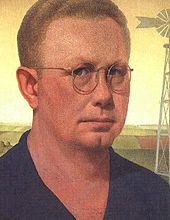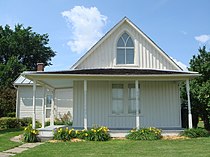American Gothic
| American Gothic | |
|---|---|
 | |
| Artist | Grant Wood |
| Year | 1930 |
| Type | Oil on beaverboard |
| Dimensions | 78 cm × 65.3 cm (30+3⁄4 in × 25+3⁄4 in) |
| Location | Art Institute of Chicago, Chicago |
American Gothic is a 1930 painting by Grant Wood in the collection of the Art Institute of Chicago. A character study of a man and a woman portrayed in front of a home, American Gothic is one of the most famous American paintings of the 20th century, and has been widely parodied in American popular culture.[1][2]
Wood was inspired to paint what is now known as the American Gothic House in Eldon, Iowa, along with "the kind of people [he] fancied should live in that house". It depicts a farmer standing beside his daughter – often mistakenly assumed to be his wife.[1][3] The painting's name is a word play on the house's architectural style, Carpenter Gothic.
The figures were modeled by Wood's sister
From 2016 to 2017, the painting was displayed in Paris at the Musée de l'Orangerie and in London at the Royal Academy of Arts, in its first showings outside the United States.[5][6][7]
Creation

In August 1930,


At the time, Wood classified it as one of the "cardboardy frame houses on Iowa farms" and considered it "very paintable".[10] After obtaining permission from the house's owners, Selma Jones-Johnston and her family, Wood made a sketch the next day in oil paint on paperboard from the front yard. This sketch depicted a steeper roof and a longer window with a more pronounced ogive than on the actual house – features which eventually adorned the final work.
Wood decided to paint the house along with, in his words, "the kind of people [he] fancied should live in that house".[1] He recruited his sister, Nan (1899–1990), to be the model for the daughter, dressing her in a colonial-print apron mimicking 20th-century rural Americana. While preparing for the painting, Wood requested that she make the apron herself and include rickrack trim to better reflect the time period. As rickrack was no longer available in stores, Nan removed trim from their mother Hattie's old dresses to apply to the apron.[11] The model for the father was the Wood family's dentist,[12] Dr. Byron McKeeby (1867–1950) from Cedar Rapids, Iowa.[13][14] Nan told people that her brother had envisioned the pair as father and daughter, not husband and wife, which Wood himself confirmed in his letter to a Mrs. Nellie Sudduth in 1941: "The prim lady with him is his grown-up daughter."[1][15]
Elements of the painting stress the vertical that is associated with
Reception and interpretation
Wood entered the painting in a competition at the
Art critics who had favorable opinions about the painting, such as
However, with the deepening of the Great Depression not too long after the painting was made, American Gothic came to be seen as a depiction of the steadfast American pioneer spirit. Wood assisted this interpretive transition by renouncing his bohemian youth in Paris and grouping himself with populist Midwestern painters such as John Steuart Curry and Thomas Hart Benton, who revolted against the dominance of East Coast art circles. Wood was quoted in this period as stating, "All the good ideas I've ever had came to me while I was milking a cow."[1] Wood intended the painting to depict the farmer and his daughter as survivors, to pay homage to the strength of the rural community, and to provide reassurance in a time of great economic upset. [21]
American art historian Wanda M. Corn thinks that Wood was not painting a modern couple, but rather one of the past, pointing to the fact that Wood directed the models to wear old-fashioned clothing which he found inspiration for by consulting his family photo album. Wood even posed the figures in a way that resembled long-exposure photographs of Midwestern families that dated before World War I.[22]
Art historian Tripp Evans interpreted it in 2010 as an "old-fashioned
In 2019, culture writer
Parodies and other cultural references
The Depression-era understanding of the painting as depicting an authentically American scene prompted the first well-known parody, a 1942 photo by Gordon Parks taken in Washington, D.C. of cleaning woman Ella Watson.[1]
American Gothic is a frequently parodied image. It has been lampooned in
In 2023, Google released a commercial for their smart phone depicting a father and daughter recreating the scene at the original house. It also includes similar poses in numerous other settings, including in wet suits, dressed as skeletons, camping and in ski suits. [29]
See also
References
- ^ a b c d e f g h Fineman, Mia (June 8, 2005). "The Most Famous Farm Couple in the World: Why American Gothic still fascinates". Slate.
- ^ a b Güner, Fisun (February 8, 2017). "How American Gothic became an icon". BBC. Retrieved March 2, 2017.
- ^ a b "About This Artwork: American Gothic". The Art Institute of Chicago. Archived from the original on May 28, 2010. Retrieved June 20, 2010.
- ^ "The Painting". American Gothic House. Archived from the original on November 29, 2014. Retrieved January 8, 2015.
- ^ Cumming, Laura (February 5, 2017). "American Gothic: a state visit to Britain for the first couple". The Guardian. Retrieved March 2, 2017.
- ^ "American Painting in the 1930s: Musée de l'Orangerie". musee-orangerie.fr. Archived from the original on 26 October 2017. Retrieved 2 March 2017.
- ^ Artwork 6565 Art Institute of Chicago
- ^ a b "American Gothic House Center". Wapello County Conservation Board. Archived from the original on June 18, 2009. Retrieved July 14, 2009.
- ^ Garwood, p. 119
- ^ Quoted in Hoving, p. 36
- ISBN 9781644531655.
- ^ a b Semuels, Alana (April 30, 2012). "At Home in a Piece of History". Los Angeles Times. Retrieved February 25, 2013.
- ^ "Dr. Byron McKeeby's contribution to Grant Wood's 'American Gothic'"
- ^ "The models for American Gothic". Archived from the original on January 6, 2015. Retrieved January 8, 2015.
- ^ "Grant Wood's Letter Describing American Gothic". Campsilos.org. Archived from the original on November 15, 2018. Retrieved April 12, 2010.
- ^ "Grant Wood's American Gothic". Smarthistory at Khan Academy. Retrieved December 18, 2012.
- ^ Quoted in Biel, p. 22
- ISBN 978-0-393-05912-0.
- ^ Andréa Fernandes. "mental_floss Blog » Iconic America: Grant Wood". Mentalfloss.com. Archived from the original on February 15, 2009. Retrieved April 12, 2010.
- ^ "Grant Wood's Letter Describing American Gothic". www.campsilos.org. Archived from the original on May 4, 2021. Retrieved June 30, 2020.
- ^ Matinique, Elena. "American Gothic – The Story Behind Grant Wood's Iconic Painting". Widewalls. Retrieved March 6, 2023.
- JSTOR 4104340.
- ^ Deborah Solomon (October 28, 2010). "Gothic American". The New York Times.
- ISBN 0-86547-001-4.
- ISBN 978-0500239636
- ^ Sacks, Sam (April 21, 2024). "'The Geography of the Imagination' Review: Guy Davenport's Genius". Wall Street Journal. Retrieved April 21, 2024.
- ^ BBC History Revealed magazine; Issue No. 108 (June 2022); p. 63
- ^ "When art imitates art". www.telegraph.co.uk.
- ^ "The Google American Gothic Commercial".
Sources
- Garwood, Darrell (1944). Artist in Iowa: A Life of Grant Wood. New York: W. W. Norton & Company. OCLC 518305.
- Hoving, Thomas (2005). American Gothic: The Biography of Grant Wood's American Masterpiece. New York: Chamberlain Bros. ISBN 978-1-59609-148-1.
- Girod, André (2014). American Gothic: une mosaïque de personnalités américaines (in French). Paris: L'Harmattan. ISBN 978-2-343-04037-0.
Further reading
- Howard, Beth M. (March 18, 2018). "Masterpiece Rental: My Life in the 'American Gothic' House". The New York Times. ISSN 0362-4331. Retrieved April 5, 2018. (contains image of first Wood sketch of the house)
External links
| External videos | |
|---|---|
 | |
- Grant Wood and Frank Lloyd Wright Compared
- About the painting, on the Art Institute's site
- Slate article about American Gothic
- American Gothic, French
- American Gothic: A Life of America's Most Famous Painting
- Television Commercials (1950s–1960s) contains General Mills New Country Corn Flakes commercial
- American Gothic sculpture removed from Michigan Avenue
- American Gothic Parodies collection
- November 18, 2002, National Public Radio Morning Edition report about American Gothic by Melissa Gray that includes an interview with Art Institute of Chicago curator Daniel Schulman.
- June 6, 1991, National Public Radio Morning Edition report on Iowa's celebration of the centennial of Grant Wood's birth by Robin Feinsmith. Several portions of the report focus on American Gothic.
- February 13, 1976, National Public Radio All Things Considered Cary Frumpkin interview with James Dennis, author of Grant Wood: A Study in American Art and Culture. The interview contains a discussion about American Gothic.
